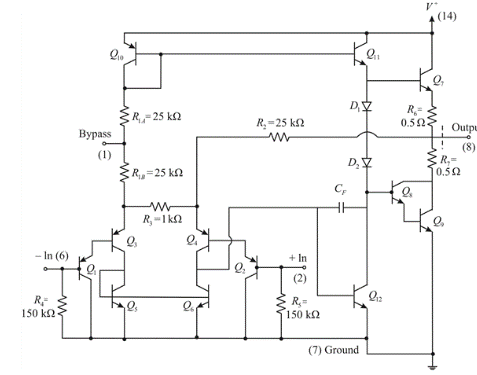
(a)
To find: The quiescent collector currents in transistors.
(a)
Answer to Problem 15.68P
The quiescent collector currents in transistors are
Explanation of Solution
Given:
Given LM380 power amplifier circuit as

Calculation:
Assuming matched input transistor and neglecting the base currents. For zero input voltages, the currents in
Since
Hence, the collector current is
Since, the collector currents of
Therefore,
Conclusion:
Therefore, the quiescent collector currents in transistors are
(b)
To find: The quiescent currents inD1, D2, Q7, Q8 and Q9.
(b)
Answer to Problem 15.68P
The quiescent currents are
Explanation of Solution
Given:
Diodes D1 and D2 and transistors Q7, Q8, Q9 are all matched.
Calculation:
The currents in
Hence, the emitter currents of transistor
Therefore, the diode currents are
The voltage across base of
From the circuit given
Thus, the collector current through the transistor
Now, substitute all values in the above expression we have
The base emitter voltages across the transistor
Since,
Taking exponential on both sides,
As the above equation is in the form of polynomial equation, hence the roots are
Thus, the required collector current at transistor
Now, substitute the value of
Thus, the required collector current at transistor
Now, substitute the value of
Thus, the required collector current at transistor
Conclusion:
Thus, the quiescent currents are
(c)
To calculate: The quiescent power dissipated in the amplifier.
(c)
Answer to Problem 15.68P
The required power is
Explanation of Solution
Given LM380 power amplifier circuit as

Calculation:
For no load,
The power dissipated in the amplifier is
Conclusion:
Therefore, the required power is
Want to see more full solutions like this?
Chapter 15 Solutions
Microelectronics: Circuit Analysis and Design
- Discuss the significance of VRM (Voltage Regulator Module) design and its impact on CPU stability and performance, especially in high-end gaming rigs.arrow_forward1. What are the two ways of generating DSB_SC.2. What are the applications of balanced modulator?3. What are the advantages of suppressing the carrier?4. What are the advantages of balanced modulator?5. What are the advantages of Ring modulator?6. Write the expression for the output voltage of a balanced modulator?arrow_forward. Draw the hierarchy of digital modulation techniques.arrow_forward
- Sketch the output of the following MOSFET sampling curvuitarrow_forward3) For the given circuit;→Setup state thetransition table →Sketch state thesatate transitiondiagram→Derive the stateequationsarrow_forwardGiven the information below. Your task is to write a program that samples an analog signal a0 as illustrated below using the MSP430’sADC12 device. Answer the following questions. A. What is the maximum and minimum input voltage of the input signal a0?B. What is the duration of one period of the input signal a0 in milliseconds?C. Let us assume that we configure the MSP430’s device to sample analog input a0 with the sampling frequency fsample = 2 KHz. How many samples, M, do we have per one period of the input analog signal? Fill in the following table by determining the first 6 samples and the last (Mth) sample. Assume that our sampling is synchronized with the a0 (i.e., the first sample is taken at the very beginning of an a0 period). Assume reference voltages VR+ = 2.5 V and VR- = 0V. Sample Number t [ms] a0 [V] Sample value [decimal] 1 2 3 4 5 6 M = E. If you know that…arrow_forward
- Explain why it is important to minimise VCM - Vg, even if the instrumentation amplifierhas excellent common-mode rejection performance.arrow_forwardFind the output waveform for the multiplexer attached below.arrow_forwardExplain by block diagram and equations the PLL method of Demodulating FMarrow_forward
- Discuss the significance of VRM (Voltage Regulator Module) design in motherboard quality and its impact on CPU overclocking.arrow_forwardDefine and explain the difference between analogue and digital signals elaborating on the advantages and disadvantages of both.arrow_forwardEx. 1632. A 120VAC_RMS, 60Hz line is connected to an SCR with a firing angle of 70 degrees. What is the RMS voltage at the SCR output? Can you accurately plot the SCR-output voltage? ans:1arrow_forward
 Introductory Circuit Analysis (13th Edition)Electrical EngineeringISBN:9780133923605Author:Robert L. BoylestadPublisher:PEARSON
Introductory Circuit Analysis (13th Edition)Electrical EngineeringISBN:9780133923605Author:Robert L. BoylestadPublisher:PEARSON Delmar's Standard Textbook Of ElectricityElectrical EngineeringISBN:9781337900348Author:Stephen L. HermanPublisher:Cengage Learning
Delmar's Standard Textbook Of ElectricityElectrical EngineeringISBN:9781337900348Author:Stephen L. HermanPublisher:Cengage Learning Programmable Logic ControllersElectrical EngineeringISBN:9780073373843Author:Frank D. PetruzellaPublisher:McGraw-Hill Education
Programmable Logic ControllersElectrical EngineeringISBN:9780073373843Author:Frank D. PetruzellaPublisher:McGraw-Hill Education Fundamentals of Electric CircuitsElectrical EngineeringISBN:9780078028229Author:Charles K Alexander, Matthew SadikuPublisher:McGraw-Hill Education
Fundamentals of Electric CircuitsElectrical EngineeringISBN:9780078028229Author:Charles K Alexander, Matthew SadikuPublisher:McGraw-Hill Education Electric Circuits. (11th Edition)Electrical EngineeringISBN:9780134746968Author:James W. Nilsson, Susan RiedelPublisher:PEARSON
Electric Circuits. (11th Edition)Electrical EngineeringISBN:9780134746968Author:James W. Nilsson, Susan RiedelPublisher:PEARSON Engineering ElectromagneticsElectrical EngineeringISBN:9780078028151Author:Hayt, William H. (william Hart), Jr, BUCK, John A.Publisher:Mcgraw-hill Education,
Engineering ElectromagneticsElectrical EngineeringISBN:9780078028151Author:Hayt, William H. (william Hart), Jr, BUCK, John A.Publisher:Mcgraw-hill Education,





